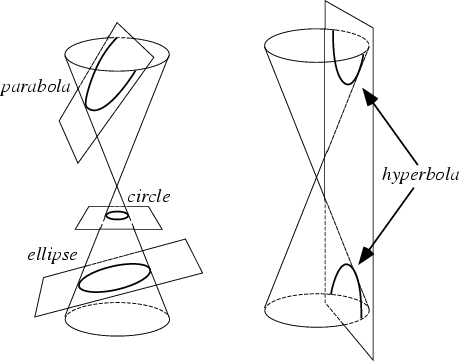|
|
|

The conic sections are the nondegenerate curves generated by the intersections of a Plane with one or two Nappes of a Cone. For a Plane parallel to a Cross-Section, a Circle is produced. The closed curve produced by the intersection of a single Nappe with an inclined Plane is an Ellipse or Parabola. The curve produced by a Plane intersecting both Nappes is a Hyperbola. The Ellipse and Hyperbola are known as Central Conics.
Because of this simple geometric interpretation, the conic sections were studied by the Greeks long before their application
to inverse square law orbits was known. Apollonius ![]() wrote the classic ancient work on the subject entitled On
Conics. Kepler
wrote the classic ancient work on the subject entitled On
Conics. Kepler ![]() was the first to notice that planetary orbits were Ellipses, and
Newton
was the first to notice that planetary orbits were Ellipses, and
Newton ![]() was then able to derive the shape of orbits mathematically using Calculus, under the assumption that
gravitational force goes as the inverse square of distance. Depending on the energy of the orbiting body, orbit shapes which
are any of the four types of conic sections are possible.
was then able to derive the shape of orbits mathematically using Calculus, under the assumption that
gravitational force goes as the inverse square of distance. Depending on the energy of the orbiting body, orbit shapes which
are any of the four types of conic sections are possible.
A conic section may more formally be defined as the locus of a point ![]() that moves in the Plane of a fixed point
that moves in the Plane of a fixed point ![]() called the Focus and a fixed line
called the Focus and a fixed line ![]() called the Directrix (with
called the Directrix (with ![]() not on
not on ![]() )
such that the ratio of the distance of
)
such that the ratio of the distance of ![]() from
from ![]() to its distance from
to its distance from ![]() is a constant
is a constant ![]() called the
Eccentricity. For a Focus
called the
Eccentricity. For a Focus ![]() and Directrix
and Directrix ![]() , the equation is
, the equation is
In standard form, a conic section is written
See also Brianchon's Theorem, Central Conic, Circle, Cone, Eccentricity, Ellipse, Fermat Conic, Hyperbola, Nappe, Parabola, Pascal's Theorem, Quadratic Curve, Seydewitz's Theorem, Skew Conic, Steiner's Theorem
References
Besant, W. H. Conic Sections, Treated Geometrically, 8th ed. rev. Cambridge, England: Deighton, Bell, 1890.
Casey, J. ``Special Relations of Conic Sections'' and ``Invariant Theory of Conics.'' Chs. 9 and 15 in
A Treatise on the Analytical Geometry of the Point, Line, Circle, and Conic Sections, Containing
an Account of Its Most Recent Extensions, with Numerous Examples, 2nd ed., rev. enl. Dublin: Hodges, Figgis, & Co., pp. 307-332 and 462-545,
1893.
Coolidge, J. L. A History of the Conic Sections and Quadric Surfaces. New York: Dover, 1968.
Coxeter, H. S. M. and Greitzer, S. L. Geometry Revisited. Washington, DC: Math. Assoc. Amer., pp. 138-141, 1967.
Downs, J. W. Conic Sections. Dale Seymour Pub., 1993.
Iyanaga, S. and Kawada, Y. (Eds.). ``Conic Sections.'' §80 in
Encyclopedic Dictionary of Mathematics. Cambridge, MA: MIT Press, pp. 271-276, 1980.
Le Lionnais, F. Les nombres remarquables. Paris: Hermann, p. 56, 1983.
Lee, X. ``Conic Sections.''
http://www.best.com/~xah/SpecialPlaneCurves_dir/ConicSections_dir/conicSections.html
Ogilvy, C. S. ``The Conic Sections.'' Ch. 6 in Excursions in Geometry. New York: Dover, pp. 73-85, 1990.
Pappas, T. ``Conic Sections.'' The Joy of Mathematics. San Carlos, CA: Wide World Publ./Tetra, pp. 196-197, 1989.
Salmon, G. Conic Sections, 6th ed. New York: Chelsea, 1954.
Smith, C. Geometric Conics. London: MacMillan, 1894.
Sommerville, D. M. Y. Analytical Conics, 3rd ed. London: G. Bell and Sons, 1961.
Yates, R. C. ``Conics.'' A Handbook on Curves and Their Properties. Ann Arbor, MI: J. W. Edwards, pp. 36-56, 1952.
![]() Conic Sections
Conic Sections
|
|
|
© 1996-9 Eric W. Weisstein